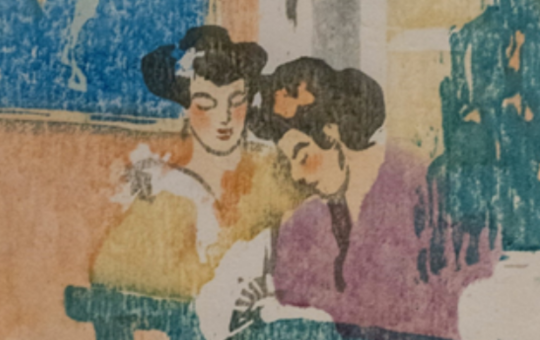
By Jenn Laqualia (She/Her/Hers), Collections Manager and Registrar


In 2023, the Richard and Carole Cocks Art Museum (RCCAM) acquired two works on paper. Both pieces were exhibited in the fall of 2023 as part of the “A Golden Time: Turn of the Century Ohio Women Artists.” While RCCAM has recently focused strongly on acquiring and exhibiting female-identifying artists, specifically with a connection to Ohio, these two works highlight female-identifying artists at the turn of the century who were presumed members of the LGBTQ+ community. Maud Hunt Squire and Ethel Mars first met at the McMicken School of Design in Cincinnati around 1894-1895 where they were both studying, and soon became close friends. Their close friendship then blossomed into a lifelong partnership. At the turn of the century, this was socially unacceptable. While no official documentation exists that the two women were in fact a lesbian couple, we can allude to Gertrude Stein’s 1923 poem Miss Furr and MIss Skeene, which is presumed to be about the two women. What we do know is that Mars and Squire were breaking social barriers as both queer and female-identifying artists at a time where female-identifying persons were not given the same training and respect as male-identifying persons.
Ethel Mars

Mars was born on September 19th, 1876 in Springfield, Illinois. She specialized in painting and printmaking in the early 20th century. In 1903 and 1904, both women’s works were exhibited at joint shows at the Cincinnati Art Museum. Beyond this, because of the unfair injustices towards female-identifying artists at the time, Mars was unable to find work in the United States. Thus, along with her partner, she relocated to Paris in 1906.
The people of Paris were much more receptive to Mars and Squire’s work. The couple moved back to the states during World War I, settling in Provincetown, Massachusetts, but returned to France at the war’s conclusion. They spent many years creating art in Venice on the French Riviera, a popular artists’ hub for the time.
Mars frequently defied stereotypes given to female-identifying persons at the time, “often dying her hair purple and wearing orange lipstick” (Collins 2021).
Mars passed away on March 23rd, 1959 in Venice. Her work has been displayed and collected in many museums globally. For a listing of her works, please see the bibliography on the Mary Ryan Gallery webpage.
Mars is remembered for her beautiful, colorful depictions of “landscapes, portraits, domestic vignettes, street and café scenes” (Mary Ryan Gallery, n.d.).
Maud Hunt Squire

Maud Hunt Squire was born on January 30, 1873 in Cincinnati, Ohio. At 21 years old, she attended the Cincinnati Art Academy for art education, at a tumultuous time for female-identifying artists. This was where she met Mars, who was also studying at the academy. In addition to her incredible artwork, her and Mars were both children’s book illustrators. While both Mars and Squire were known for their drawings, paintings, and prints, Maud continued to illustrate books throughout her lifetime (Mary Ryan Gallery, n.d.). Both Squire and Mars, after moving to Provincetown, Massachusetts for a brief time period, studied white line woodcuts, that would hereafter be called “Provincetown Prints.” While Mars continued to create art throughout her lifetime, Maud “stopped all artistic work after the early 1930s” (Mary Ryan Gallery, n.d.). Both women would go into hiding during the Second World War in France. While there is no documented reason for this, history tells us that members of the LGBTQ+ community were a target for prosecution and were regularly sent to concentration camps during this time.
Maud Hunt Squire passed away on October 25, 1954 in Venice, and is buried next to Mars in a companion plot in France. For a listing of her works, please visit the Mary Ryan Gallery webpage.

Mars and Squire were incredibly talented artists and illustrators at the turn of the century, and also brought recognition to the LGBTQ+ community in both the United States and in Europe, at a time where it was significantly stigmatized to be a queer female-identifying person. May their risks and successes be remembered this June and ALL year as many queer artists continue to struggle to be seen and respected in the art world.
Happy Pride!
References:
Julie Collins, Smith Museum of Fine Art at Auburn University. June 9, 2021. Art is Pride: A Look At the Lives of Maud Hunt Squire and Ethel Mars. https://jcsm.auburn.edu/art-is-pride-a-look-at-the-lives-of-maud-hunt-squire-and-ethel-mars/
Mary Ryan Gallery, n.d. Ethel Mars. https://maryryangallery.com/artists/ethel-mars/
Mary Ryan Gallery, n.d. Maud Hunt Squire. https://maryryangallery.com/artists/maud-hunt-squire/
Stein, Gertrude. July 1923. Miss Furr and Miss Skeene. Vanity Fair. https://archive.vanityfair.com/article/1923/7/miss-furr-and-miss-skeene
Jennifer (Jenn) Laqualia, Collections Manager and Registrar, joined the Richard and Carole Cocks Art Museum in January 2024. Jenn has lived all over the United States, but spent much of her life in Washington, D.C. visiting the many museums there with family and friends. In addition to her passion for museums and public outreach, she is also a history buff, an advocate for DEAIB and LGBTQ+ rights, and animal welfare.


